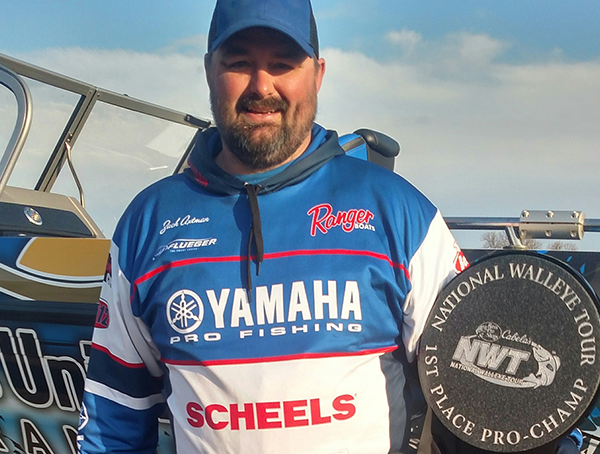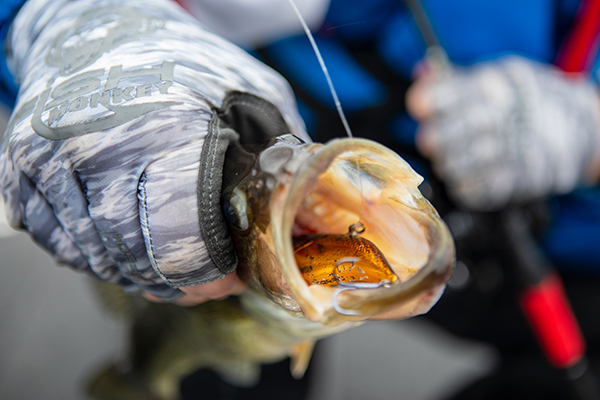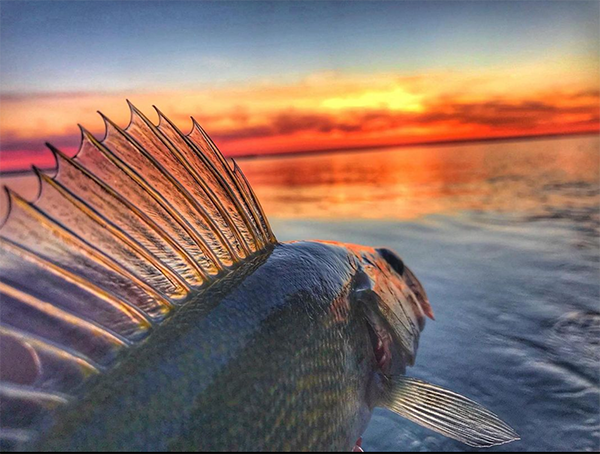Yamaha Pro Zach Axtman Caught His First One At Age Six on Devils Lake
When your father and uncle help you catch your first walleye when you’re just six years old, you live only 60 miles from one of the best walleye lakes in the United States, and there are tournament opportunities available practically every week during the summer, it’s hard not to become a walleye fisherman.

“Here in North Dakota where I live, the walleye is our largemouth bass,” laughs Yamaha Pro Zach Axtman, who today, more than 30 years later, has fished for walleye in seven states while competing in four different professional walleye tournament organizations.
He still rates Devils Lake, however, where he caught that first walleye, as his overall favorite place to fish. “It’s one of the most unusual lakes in America,” Axtman continues. “It is a completely natural body of water without a major tributary feeding it, or an outlet for the water to leave. It’s a large basin, and over the years the lake has actually grown considerably. Today I’m sure the size is at least 200,000 acres.
“What we all love about Devils Lake is the diversity of how you can catch walleyes there. It has shallow and deep water, excellent structure, and abundant cover that allows you to choose how you want to fish. Jigging, cranking, drifting, and trolling are all popular techniques there.”
In contrast to the largemouth bass, walleye prefer clearer, slightly cooler water and rocky habitat, which is why they are the dominant and most popular species among anglers throughout the upper Midwest. Comprehensive management and stocking programs have established successful walleye fisheries in lakes and rivers as far west as Washington’s Columbia River, eastward to New York and Vermont, and even as far south as Arkansas.
“Tournament fishing for walleye has been popular throughout this region for years,” explains the Yamaha Pro, “but our tournaments are not quite the same as most Southern bass tournaments. We’re allowed to troll if we want to fish that way and we can also use live bait, neither of which are allowed in bass tournaments. Our tournaments normally last only two days, instead of three or four, and many of our events are team tournaments.
“Regulations are not uniform from state to state, either, and may vary from lake to lake in the same state. Normally, we have a five-fish limit, but there may or may not be a length limit. Some states have a no-cull regulation, too, meaning you have to keep the first five walleye you catch. Other states have a slot size limit. For sure, you have to be thoroughly familiar with the different regulations where you’re fishing.”

The four dominant tournament organizations include the Yamaha-sponsored AIM (Anglers Insight Marketing) Weekend Walleye Series; the Casino Cup Walleye Circuit, organized by different gambling casinos along the Missouri River; the Cabela’s® National Walleye Tour (NWT), with televised events in several Midwest states; and the Bass Pro Shops® Masters Walleye Circuit (MWC), which has been conducting tournaments since 1984.
“Normally, we do have a regular weigh-in, after which the fish are released, just as in many bass tournaments,” adds Axtman, “but AIM events are completely different. They’re catch-record-release tournaments. After a walleye is caught, an observer in the boat photographs the fish, and then releases it.”

Axtman has fished in all four circuits over the years, during which time he has qualified for five Masters Walleye Circuit championships, and in 2019 he won a National Walleye Tour event on Lake Winnebago in Oshkosh, Wisconsin. With a 165-boat field, it was the largest National Walleye Tour event ever held. Over the two-day tournament he brought in 10 fish weighing 27.40 pounds, all coming from a rockpile less than six feet deep.
“I fished my first tournament, on the Masters Walleye Circuit, with my father about 15 years ago,” remembers Axtman, “and today we still fish one or two team tournaments together. As you might guess, they’re nearly always on Devils Lake, too.”
Back to Blue Life
When your father and uncle help you catch your first walleye when you’re just six years old, you live only 60 miles from one of the best walleye lakes in the United States, and there are tournament opportunities available practically every week during the summer, it’s hard not to become a walleye fisherman.

“Here in North Dakota where I live, the walleye is our largemouth bass,” laughs Yamaha Pro Zach Axtman, who today, more than 30 years later, has fished for walleye in seven states while competing in four different professional walleye tournament organizations.
He still rates Devils Lake, however, where he caught that first walleye, as his overall favorite place to fish. “It’s one of the most unusual lakes in America,” Axtman continues. “It is a completely natural body of water without a major tributary feeding it, or an outlet for the water to leave. It’s a large basin, and over the years the lake has actually grown considerably. Today I’m sure the size is at least 200,000 acres.
“What we all love about Devils Lake is the diversity of how you can catch walleyes there. It has shallow and deep water, excellent structure, and abundant cover that allows you to choose how you want to fish. Jigging, cranking, drifting, and trolling are all popular techniques there.”
In contrast to the largemouth bass, walleye prefer clearer, slightly cooler water and rocky habitat, which is why they are the dominant and most popular species among anglers throughout the upper Midwest. Comprehensive management and stocking programs have established successful walleye fisheries in lakes and rivers as far west as Washington’s Columbia River, eastward to New York and Vermont, and even as far south as Arkansas.
“Tournament fishing for walleye has been popular throughout this region for years,” explains the Yamaha Pro, “but our tournaments are not quite the same as most Southern bass tournaments. We’re allowed to troll if we want to fish that way and we can also use live bait, neither of which are allowed in bass tournaments. Our tournaments normally last only two days, instead of three or four, and many of our events are team tournaments.
“Regulations are not uniform from state to state, either, and may vary from lake to lake in the same state. Normally, we have a five-fish limit, but there may or may not be a length limit. Some states have a no-cull regulation, too, meaning you have to keep the first five walleye you catch. Other states have a slot size limit. For sure, you have to be thoroughly familiar with the different regulations where you’re fishing.”

The four dominant tournament organizations include the Yamaha-sponsored AIM (Anglers Insight Marketing) Weekend Walleye Series; the Casino Cup Walleye Circuit, organized by different gambling casinos along the Missouri River; the Cabela’s® National Walleye Tour (NWT), with televised events in several Midwest states; and the Bass Pro Shops® Masters Walleye Circuit (MWC), which has been conducting tournaments since 1984.
“Normally, we do have a regular weigh-in, after which the fish are released, just as in many bass tournaments,” adds Axtman, “but AIM events are completely different. They’re catch-record-release tournaments. After a walleye is caught, an observer in the boat photographs the fish, and then releases it.”

Axtman has fished in all four circuits over the years, during which time he has qualified for five Masters Walleye Circuit championships, and in 2019 he won a National Walleye Tour event on Lake Winnebago in Oshkosh, Wisconsin. With a 165-boat field, it was the largest National Walleye Tour event ever held. Over the two-day tournament he brought in 10 fish weighing 27.40 pounds, all coming from a rockpile less than six feet deep.
“I fished my first tournament, on the Masters Walleye Circuit, with my father about 15 years ago,” remembers Axtman, “and today we still fish one or two team tournaments together. As you might guess, they’re nearly always on Devils Lake, too.”
Back to Blue Life
